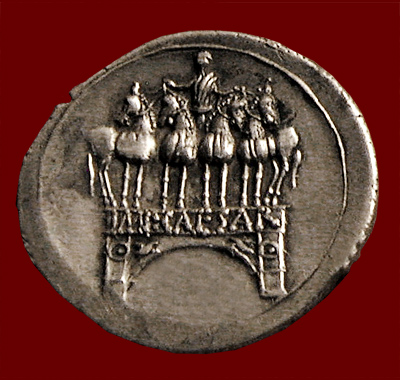
In the center of the courtyard you see a large and impressive sculpture of Augustus driving a triumphal chariot pulled by four horses (a quadriga). This was the gift of a grateful nation to the emperor, decreed by the Senate along with the title inscribed on the base of the sculptural group: PATER PATRIAE, "Father of the Fatherland." Augustus was extremely proud of this title, claiming in the record of his achievements that "all the people of Rome gave me the title Father of the Country" ("populusque Romanus universus appellavit me patrem patriae," Res Gestae 35).
As you look to the left side of the courtyard, you spot some paintings on the walls. Intrigued, you walk closer, noticing that one seems reminiscent of a culminating passage in Book 1 of the Aeneid, coming at the end of the great prophecy of Jupiter that announces a new hero, descended from Aeneas, "laden with Eastern spoils" (the standards regained from the Parthians) who will finally close the gates of war (as Augustus ceremoniously closed the gates of the Temple of Janus in 29 BCE). Here is what the later commentator on the Aeneid, Servius, said about this painting (see this detail from a sixteenth-century painting of the underworld for some sense of Furor impius):
Quidam tradunt "furor impius intus" non in aede Iani, sed in alia in foro Augusti introeuntibus ad sinistram, fuit bellum pictum et furor sedens super arma devinctus eo habitu quo poeta dixit. (Commentary on the Aeneid of Vergil 1.294)
They say that "Unholy Fury inside" is located not in the Temple of Janus but in another painting in the Forum of Augustus to the left as you enter. There war was depicted and Fury sitting bound upon arms in the exact manner as the poet described.
According to Pliny the Elder, however, this was one of two paintings in the forum by the fourth-century BCE painter Apelles, who was associated with Alexander the Great:
Romae Castorem et Pollucem cum Victoria et Alexandro Magno, item Belli imaginem restrictis ad terga manibus, Alexandro in curru triumphante. quas utrasque tabulas divus Augustus in celeberrimis partibus dicaverat simplicitate moderata. (Natural History 35.93-94)
At Rome, divine Augustus had dedicated two paintings in the most crowded parts of his Forum with restrained lack of embellishment. One showed Castor and Pollux with Victory; the other depicted the image of War with hands bound behind its back while Alexander triumphs in a chariot.
Clearly, a painting by Apelles could not have been based on the Aeneid, but Augustus may have chosen the painting because of the way that the image of shackled War could call to mind Vergil's shackled Furor.